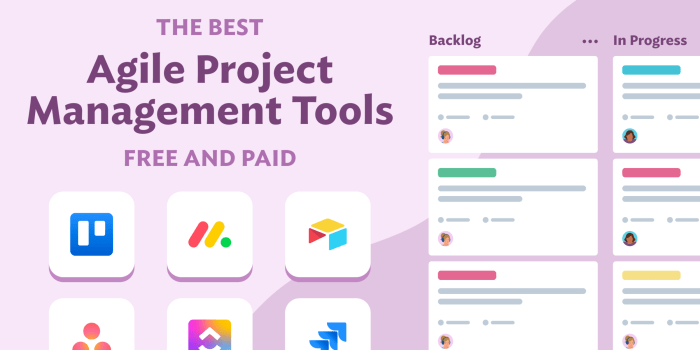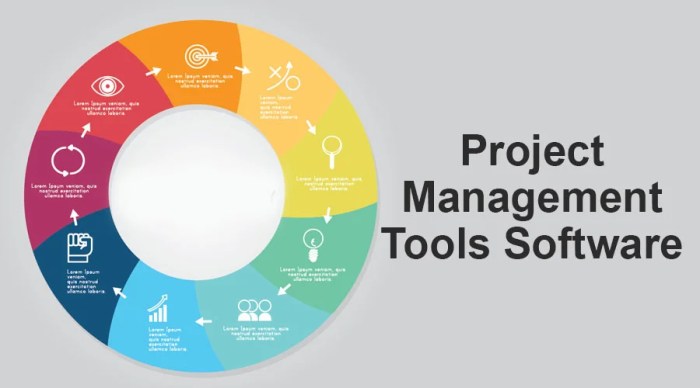Diving into the world of project management tools, these essential resources are key players in modern industries, revolutionizing how teams collaborate and execute tasks efficiently. From task management to Gantt charts, the realm of project management tools offers a diverse array of solutions to enhance productivity and streamline workflows.
As professionals seek innovative ways to optimize project processes, the right project management tool can make all the difference in achieving success and meeting deadlines with ease.
Overview of Project Management Tools
Project management tools are software applications or platforms that help individuals and teams plan, organize, and manage projects effectively. These tools play a crucial role in various industries by providing a centralized platform for collaboration, task tracking, resource allocation, and communication.
Popular Project Management Tools
- Trello: Known for its user-friendly interface and visual boards, Trello allows users to create tasks, assign them to team members, and track progress easily.
- Asana: Asana is a comprehensive project management tool that offers features like task dependencies, timeline views, and integrations with other productivity apps.
- Jira: Primarily used in software development, Jira provides robust issue tracking, agile project management, and customizable workflows for teams.
Benefits of Project Management Tools
- Improved Collaboration: Project management tools facilitate communication and collaboration among team members, leading to increased productivity and efficiency.
- Task Organization: These tools help in organizing tasks, setting priorities, and tracking progress, ensuring that projects stay on schedule.
- Resource Allocation: By providing insights into resource availability and workload distribution, project management tools help in optimizing resource allocation for better project outcomes.
Types of Project Management Tools
When it comes to project management tools, there are various categories that serve different purposes and functionalities. Let’s dive into the different types of project management tools and explore their features, advantages, and disadvantages.
Task Management Tools
Task management tools are designed to help teams organize, assign, and track their tasks effectively. These tools typically offer features such as task lists, deadlines, progress tracking, and notifications. Some popular task management tools include Trello, Asana, and Todoist.
Collaboration Tools
Collaboration tools focus on enabling team members to work together seamlessly, regardless of their location. These tools often include features like file sharing, real-time editing, messaging, and project communication channels. Examples of collaboration tools are Slack, Microsoft Teams, and Google Workspace.
Gantt Chart Tools
Gantt chart tools are used to create visual timelines of project tasks and dependencies. They help project managers and team members visualize project progress, identify bottlenecks, and adjust schedules accordingly. Popular Gantt chart tools include Microsoft Project, TeamGantt, and GanttPRO.
Kanban Tools
Kanban tools are based on the Kanban method, which emphasizes visualizing work and workflow. These tools use boards with columns to represent different stages of work, allowing teams to track tasks as they move through the workflow. Examples of Kanban tools are Kanbanize, LeanKit, and Jira Software.
Resource Management Tools
Resource management tools focus on allocating and optimizing resources across projects effectively. These tools help project managers track resource availability, assign tasks based on workload, and manage resource utilization. Some popular resource management tools include Float, Mavenlink, and Resource Guru.
Advantages and Disadvantages
Each type of project management tool comes with its own set of advantages and disadvantages. Task management tools are great for organizing individual tasks but may lack advanced project planning features. Collaboration tools facilitate team communication but can sometimes lead to information overload. Gantt chart tools provide a clear project timeline but may require manual updates. Kanban tools are excellent for visualizing workflow but may not offer detailed project tracking. Resource management tools help optimize resource allocation but can be complex to set up and maintain.
Implementation of Project Management Tools

Implementing project management tools within a team or organization involves several key steps to ensure successful adoption and integration into daily workflows.
Identify Needs and Goals
- Assess current workflows and identify pain points that can be addressed by project management tools.
- Define clear goals and objectives for implementing the tools to ensure alignment with the team’s overall strategy.
Research and Select the Right Tool
- Conduct thorough research on available project management tools in the market.
- Consider factors such as features, scalability, ease of use, and cost before selecting the tool that best fits your team’s needs.
Provide Training and Support
- Offer comprehensive training sessions to ensure team members are proficient in using the selected project management tool.
- Provide ongoing support and resources to address any issues or questions that may arise during the implementation process.
Encourage Collaboration and Communication, Project management tools
- Promote a culture of collaboration and open communication to facilitate the sharing of information and progress updates within the team.
- Utilize features within the project management tool that enhance collaboration, such as task assignments, comments, and file sharing.
Monitor Progress and Gather Feedback
- Regularly monitor the usage of the project management tool and analyze its impact on team productivity and efficiency.
- Solicit feedback from team members to identify areas for improvement and make necessary adjustments to optimize the tool’s effectiveness.
Customization and Integration of Project Management Tools

Customizing project management tools is crucial to meet the specific requirements of each project. By tailoring the tools to fit the unique needs of a project, teams can increase efficiency and effectiveness in managing tasks and resources.
Integration with Other Software Applications
Project management tools can be integrated with various software applications to streamline processes and enhance productivity. Here are some examples:
- Integration with communication tools like Slack or Microsoft Teams to facilitate real-time collaboration and communication among team members.
- Integration with cloud storage services such as Google Drive or Dropbox for easy access to project documents and files.
- Integration with time tracking software like Toggl or Harvest to monitor project progress and track billable hours.
Strategies for Effective Integration
Successfully integrating project management tools with existing workflows and processes requires careful planning and implementation. Here are some strategies to ensure a smooth integration:
- Identify key integration points and establish clear communication channels between different software applications.
- Provide training and support to team members to ensure they understand how to use the integrated tools effectively.
- Regularly review and assess the integration process to identify any areas for improvement or optimization.